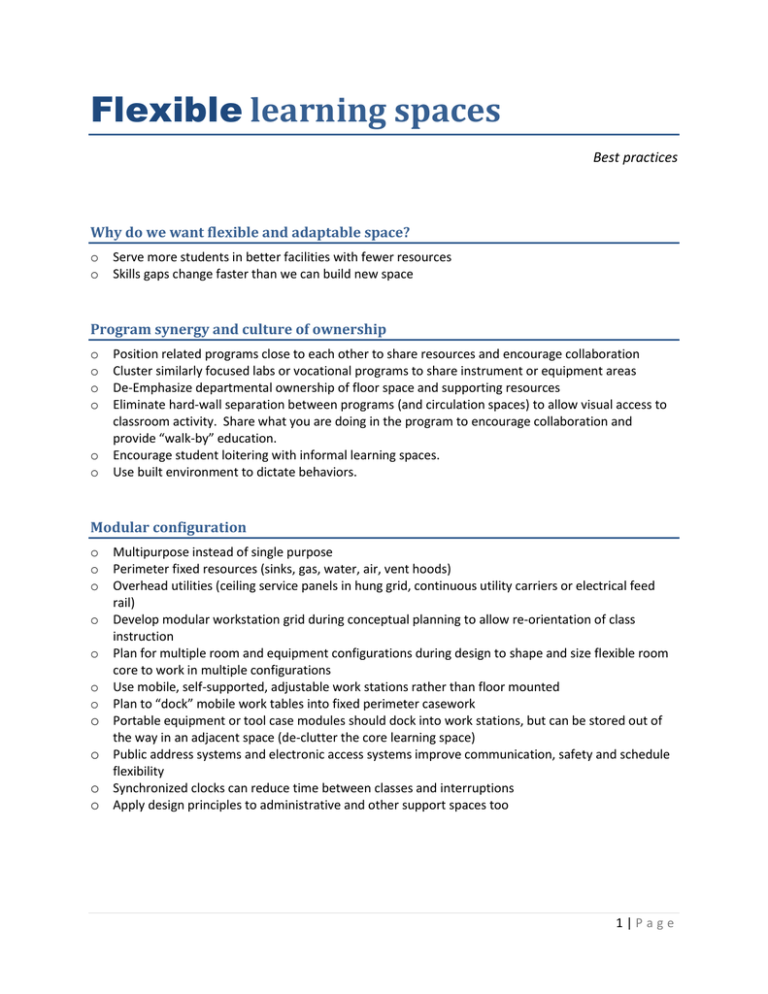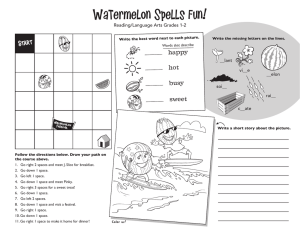Flexible learning spaces Best practices Why do we want flexible and adaptable space?
advertisement

Flexible learning spaces Best practices Why do we want flexible and adaptable space? o o Serve more students in better facilities with fewer resources Skills gaps change faster than we can build new space Program synergy and culture of ownership o o o o o o Position related programs close to each other to share resources and encourage collaboration Cluster similarly focused labs or vocational programs to share instrument or equipment areas De-Emphasize departmental ownership of floor space and supporting resources Eliminate hard-wall separation between programs (and circulation spaces) to allow visual access to classroom activity. Share what you are doing in the program to encourage collaboration and provide “walk-by” education. Encourage student loitering with informal learning spaces. Use built environment to dictate behaviors. Modular configuration o o o o o o o o o o o Multipurpose instead of single purpose Perimeter fixed resources (sinks, gas, water, air, vent hoods) Overhead utilities (ceiling service panels in hung grid, continuous utility carriers or electrical feed rail) Develop modular workstation grid during conceptual planning to allow re-orientation of class instruction Plan for multiple room and equipment configurations during design to shape and size flexible room core to work in multiple configurations Use mobile, self-supported, adjustable work stations rather than floor mounted Plan to “dock” mobile work tables into fixed perimeter casework Portable equipment or tool case modules should dock into work stations, but can be stored out of the way in an adjacent space (de-clutter the core learning space) Public address systems and electronic access systems improve communication, safety and schedule flexibility Synchronized clocks can reduce time between classes and interruptions Apply design principles to administrative and other support spaces too 1|Page Shared space o o o o o o Collective ownership instead of department or course ownership Collaborative office space for faculty with shared break out areas for private conference Use wide service corridors for study areas or equipment storage and use areas Support core flex space with adjacent modules of shared support or prep areas Minimal number of meeting rooms (offices and break out spaces used for meetings) Some space provided for long discussions (temporary ownership for the day) Shared resources o o o Assignment of Lab or vocational workstation is temporary (come in and work, then leave so somebody else can use the space). Use mobile ductless lab hoods in conditions where possible. Life cycle cost is same as ducted. Shared equipment is stored and used in shared resource spaces adjacent to flexible core learning space Overarching programming o o Minimize dedicated computer labs by incorporating laptops into lab or classroom space (at workstations) Provide shared collaborative informal learning space in program (10% to 15% of assignable space) Challenges with flexible space o o o o o o Cross contamination in labs Determining how to share support costs (custodial, maintenance, energy use, etc.) between departments Difficult to purchase the right quantity of equipment at start-up. Sometimes, after use of the space, some assets sit idle. ( i.e. Some lab hoods used for storage). Recommend buying 85% of anticipated need at start up and buy remaining after actual need is determined. Noise from building systems. Include users in the design process but don’t design just for the current users. Moving walls need to be sound proof and easy to move. 2|Page





